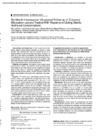Please use this identifier to cite or link to this item:
http://hdl.handle.net/10553/76922
| Title: | Six-month intravascular ultrasound follow-up of coronary bifurcation lesions treated with rapamycin-eluting stents: Technical considerations | Other Titles: | Ecografía intracoronaria durante el seguimiento en la valoración de stents liberadores de rapamicina para el tratamiento de las lesiones en bifurcación: implicaciones técnicas | Authors: | Pan, Manuel Suárez de Lezo, José Medina, Alfonso Romero, Miguel Delgado, Antonio Segura, José Ojeda, Soledad Pavlovic, Djordje Ariza, Javier Fernández-Dueñas, Jaime Herrador, Juan Ureña, Isabel |
UNESCO Clasification: | 320501 Cardiología | Keywords: | Rapamycin-eluting stent Bifurcation lesion Intravascular ultrasound Stent de rapamicina Lesiones coronarias en bifurcación, et al |
Issue Date: | 2005 | Journal: | Revista Espanola de Cardiologia | Abstract: | Introduction and objectives. In vitro studies show that stents deform when dilated laterally to access a side branch. This phenomenon may be avoided by use of a kissing balloon at the end of the procedure. However, to date, no in vivo data are available. Our objectives were to investigate the main vessel stent using intravascular ultrasound (IVUS) at six-month follow-up in 55 patients with bifurcation lesions treated using rapamycin-eluting stents and to examine the effect of technical factors.Patients and method. All patients were treated using provisional or T stents. At 6 months, IVUS measurements were made in the main vessel at both proximal and distal ends of the stent, in reference segments, immediately below the side branch ostium, and at the points where the lumen was smallest and where stent expansion was greatest.Results. The lumen area immediately below the side branch ostium was significantly smaller than that at the point of maximum stent expansion (6.7 [1.8] vs 5.1 [1.3] mm(2); P <.05). Underexpansion was not influenced by use of a kissing balloon (stent area immediately under the side branch ostium: 5.5 [0.9] vs 5.6 [1.6] mm(2); P=NS) and only one patient experienced restenosis at this point. The lumen areas at the proximal and distal edges of the stent were almost identical in patients who did or did not undergo balloon dilation beyond the ends of the stent.Conclusions. Stent underexpansion below the side branch ostium was frequently found following provisional or T stenting of bifurcation lesions. This minor stent deformity was not prevented by use of a kissing balloon nor by any specific side branch treatment and had no significant impact on the restenosis rate. Introducción y objetivos. Los estudios in vitro han mostrado que el stent se deforma cuando se dilata lateralmente para acceder a un ramo colateral. Así, se han propuesto algunas técnicas para evitar este fenómeno; sin embargo, no hay información in vivo disponible. El objetivo es investigar los hallazgos ultrasónicos a los 6 meses en 55 pacientes con lesiones localizadas en bifurcación tratados mediante stents de rapamicina. Pacientes y método. Todos los pacientes fueron tratados con stent en el vaso principal y stent o dilatación con balón en el ramo colateral. Se analizaron los bordes del stent, los segmentos de referencia, el diámetro mínimo de la luz, el punto inmediatamente tras la salida del ramo colateral y el stent en el punto de máxima expansión. Resultados. El área de la luz en el punto inmediatamente tras la salida del ramo colateral fue significativamente más pequeña que en el punto de máxima expansión (6,7 ± 1,8 frente a 5,1 ± 1,3 mm²; p < 0,05). Esta inexpansión del stent no estuvo influida por el uso del inflado simultáneo de balones al final del procedimiento (área del stent inmediatamente bajo el origen del ramo colateral, 5,5 ± 0,9 frente a 5,6 ± 1,6 mm²; p = NS). El área de la luz en los bordes fue prácticamente idéntica entre pacientes con y sin inflado de balón más allá de los límites del stent. Conclusiones. Cierto grado de inexpansión del stent inmediatamente después de la salida del ramo colateral fue un hallazgo frecuente en pacientes con bifurcaciones tratados con stents en el ramo principal y stent provisional en el ramo colateral. Esta deformidad no fue prevenida por variables técnicas y no tuvo un impacto significativo en la incidencia de reestenosis. |
URI: | http://hdl.handle.net/10553/76922 | ISSN: | 0300-8932 | DOI: | 10.1016/S1885-5857(06)60415-5 | Source: | Revista Española de Cardiología [ISSN 0300-8932], v. 58 (11), p. 1278-1286, (Noviembre 2005) |
| Appears in Collections: | Artículos |
Items in accedaCRIS are protected by copyright, with all rights reserved, unless otherwise indicated.
